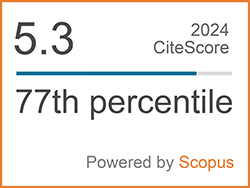Phenol Removal through Horseradish Peroxidase Immobilization on Ultrafiltration Membranes: Comparative Analysis of Immobilization Methods and Fouling Patterns
Abstract
Keywords
[1] C. R. Girish and V. R. Murty, “Adsorption of phenol from aqueous solution using Lantana camara, forest waste: Kinetics, isotherm, and thermodynamic studies,” International Scholarly Research Notices, vol. 2014, 2014, Art. no. 201626.
[2] I. D. Buchanan and J. A. Nicell, “Model development for horseradish peroxidase catalyzed removal of aqueous phenol,” Biotechnology and Bioengineering, vol. 54, no. 3, pp. 251–261, 1997.
[3] A. T. Nguyen and R.-S. Juang, “Photocatalytic degradation of p-chlorophenol by hybrid H2O2 and TiO2 in aqueous suspensions under UV irradiation,” Journal of Environmental Management, vol. 147, pp. 271–277, 2015.
[4] A. M. Klibanov, B. Alberti, E. Morris, and L. Felshin, “Enzymatic removal of toxic phenols and anilines from waste waters,” Applied Biochemistry and Biotechnology, vol. 2, no. 5, 1980, Art. no. 6449569.
[5] M. Djebbar, F. Djafri, M. Bouchekara, and A. Djafri, “Adsorption of phenol on natural clay,” Applied Water Science, vol. 2, pp. 77–86, 2012.
[6] B. Xie, J. Qin, S. Wang, X. Li, H. Sun, and W. Chen, “Adsorption of phenol on commercial activated carbons: Modelling and interpretation,” International Journal of Environmental Research and Public Health, vol. 17, no. 3, p. 789, 2020.
[7] J. Liu, J. Xie, Z. Ren, and W. Zhang, “Solvent extraction of phenol with cumene from wastewater,” Desalination and Water Treatment, vol. 51, no. 19–21, pp. 3826–3831, 2013.
[8] L. G. C. Villegas, N. Mashhadi, M. Chen, D. Mukherjee, K. E. Taylor, and N. Biswas, “A short review of techniques for phenol removal from wastewater,” Current Pollution Reports, vol. 2, pp. 157–167, 2016.
[9] F. Zhang, B. Zheng, J. Zhang, X. Huang, H. Liu, S. Guo, and J. Zhang, “Horseradish peroxidase immobilized on graphene oxide: Physical properties and applications in phenolic compound removal,” The Journal of Physical Chemistry C, vol. 114, no. 18, pp. 8469–8473, 2010.
[10] N. C. Veitch, “Horseradish peroxidase: A modern view of a classic enzyme,” Phytochemistry, vol. 65, no. 3, pp. 249–259, 2004.
[11] J. W. Tams and K. G. Welinder, “Unfolding and refolding of Coprinus cinereus peroxidase at high pH, in urea, and at high temperature. Effect of organic and ionic additives on these processes,” Biochemistry, vol. 35, no. 23, pp. 7573–7579, 1996.
[12] Y. Yuan, J. Shen, and S. Salmon, “Developing enzyme immobilization with fibrous membranes: Longevity and characterization considerations,” Membranes, vol. 13, no. 5, p. 532, 2023.
[13] J. Zdarta, K. Jankowska, K. Bachosz, O. Degórska, K. Kaźmierczak, L. N. Nguyen, L. D. Nghiem, and T. Jesionowski, “Enhanced wastewater treatment by immobilized enzymes,” Current Pollution Reports, vol. 7, pp. 167–179, 2021.
[14] M. Motsa, P. P. Mamba, H. J. Ogola, T. A. Msagati, B. B. Mamba, and T. T. Nkambule, “Laccase-coated polyethersulfone membranes for organic matter degradation and removal,” Journal of Membrane Science and Research, vol. 8, no. 1, 2022, doi: 10.22079/JMSR.2021.139576.1418.
[15] Y. Zhu, F. Qiu, J. Rong, T. Zhang, K. Mao, and D. Yang, “Covalent laccase immobilization on the surface of poly(vinylidene fluoride) polymer membrane for enhanced biocatalytic removal of dyes pollutants from aqueous environment,” Colloids and Surfaces B: Biointerfaces, vol. 191, 2020, Art. no. 111025.
[16] I. Alemzadeh and S. Nejati, “Phenols removal by immobilized horseradish peroxidase,” Journal of Hazardous Materials, vol. 166, no. 2, pp. 1082–1086, 2009.
[17] U. W. Siagian, K. Khoiruddin, A. K. Wardani, P. T. Aryanti, I. N. Widiasa, G. Qiu, Y. P. Ting, and I. G. Wenten, “High-performance ultrafiltration membrane: Recent progress and its application for wastewater treatment,” Current Pollution Reports, vol. 7, no. 4, pp. 1–15, 2021.
[18] J. Luo, A. S. Meyer, G. Jonsson, and M. Pinelo, “Enzyme immobilization by fouling in ultrafiltration membranes: Impact of membrane configuration and type on flux behaviour and biocatalytic conversion efficacy,” Biochemical Engineering Journal, vol. 83, pp. 79–89, 2014.
[19] H.-C. Zhang, S.-X. Gao, and G.-P. Sheng, “Immobilising enzyme-like ligand in the ultrafiltration membrane to remove the micropollutant for the ultrafast water purification,” Journal of Membrane Science, vol. 636, 2021, Art. no. 119566.
[20] H. Hemeda and B. Klein, “Effects of naturally occurring antioxidants on peroxidase activity of vegetable extracts,” Journal of food Science, vol. 55, no. 1, pp. 184–185, 1990.
[21] N. Caza, J. Bewtra, N. Biswas, and K. Taylor, “Removal of phenolic compounds from synthetic wastewater using soybean peroxidase,” Water Research, vol. 33, no. 13, pp. 3012–3018, 1999.
[22] M. M. Bradford, “A rapid and sensitive method for the quantitation of microgram quantities of protein utilizing the principle of protein-dye binding,” Analytical Biochemistry, vol. 72, no. 1–2, pp. 248–254, 1976.
[23] J. Hermia, “Constant pressure blocking filtration laws – Application to powerlaw non-newtonian fluids,” Transactions of the Institution of Chemical Engineers, vol. 60, no. 3, pp. 183–187, 1982.
[24] M. Kallioinen, M. Pekkarinen, M. Mänttäri, J. Nuortila-Jokinen, and M. Nyström, “Comparison of the performance of two different regenerated cellulose ultrafiltration membranes at high filtration pressure,” Journal of Membrane Science, vol. 294, no. 1, pp. 93–102, 2007.
[25] H.-S. Wang, Q.-X. Pan, and G.-X. Wang, “A biosensor based on immobilization of horseradish peroxidase in chitosan matrix cross-linked with glyoxal for amperometric determination of hydrogen peroxide,” Sensors, vol. 5, no. 4, pp. 266–276, 2005.
[26] N. K. Verma and N. Raghav, “Comparative study of covalent and hydrophobic interactions for α-amylase immobilization on cellulose derivatives,” International Journal of Biological Macromolecules, vol. 174, pp. 134–143, 2021, doi: 10.1016/j.ijbiomac.2021.01.033.
[27] J. Kujawa, M. Głodek, G. Li, S. I. Al-Gharabli, K. Knozowska, and W. Kujawski, “Highly effective enzymes immobilization on ceramics: Requirements for supports and enzymes,” The Science of the Total Environment, vol. 801, 2021, Art. no. 149647.
[28] J. W. Chew, J. Kilduff, and G. Belfort, “The behaviour of suspensions and macromolecular solutions in crossflow microfiltration: An update,” Journal of Membrane Science, vol. 601, 2020, Art. no. 117865.
[29] S.-H. Cho, J. Shim, S.-H. Yun, and S.-H. Moon, “Enzyme-catalyzed conversion of phenol by using immobilized horseradish peroxidase (HRP) in a membraneless electrochemical reactor,” Applied Catalysis A: General, vol. 337, no. 1, pp. 66–72, 2008.
[30] A. Azizi, M. Abouseoud, and A. Ahmedi, “Phenol removal by soluble and alginate entrapped turnip peroxidase,” Journal of Biochemical Technology, vol. 5, no. 4, pp. 795–800, 2014.
[31] S. T. D. de Barros, C. M. G. Andrade, E. S. Mendes, and L. Peres, “Study of fouling mechanism in pineapple juice clarification by ultrafiltration,” Journal of Membrane Science, vol. 215, no. 1, pp. 213–224, 2003.
[32] T. Sokač, M. Gojun, A. J. Tušek, A. Šalić, and B. Zelić, “Purification of biodiesel produced by lipase catalysed transesterification by ultrafiltration: Selection of membranes and analysis of membrane blocking mechanisms,” Renewable Energy, vol. 159, pp. 642–651, 2020.
[33] A. Cassano, M. Marchio, and E. Drioli, “Clarification of blood orange juice by ultrafiltration: Analyses of operating parameters, membrane fouling and juice quality,” Desalination, vol. 212, no. 1, pp. 15–27, 2007.
[34] F. Marpani, M. K. Zulkifli, F. H. Ismail, and S. M. Pauzi, “Immobilization of alcohol dehydrogenase in membrane: Fouling mechanism at different transmembrane pressure,” Journal of the Korean Chemical Society, vol. 63, no. 4, pp. 260–265, 2019.
[35] R. M. D. Machado, R. N. Haneda, B. P. Trevisan, and S. R. Fontes, “Effect of enzymatic treatment on the cross-flow microfiltration of açaí pulp: Analysis of the fouling and recovery of phytochemicals,” Journal of Food Engineering, vol. 113, no. 3, pp. 442–452, 2012.
[36] M. Celebi, M. A. Kaya, M. Altikatoglu, and H. Yildirim, “Enzymatic decolorization of anthraquinone and diazo dyes using horseradish peroxidase enzyme immobilized onto various polysulfone supports,” Applied Biochemistry and Biotechnology, vol. 171, pp. 716–730, 2013.
[37] H. Zhang, J. Luo, J. M. Woodley, and Y. Wan, “Confining the motion of enzymes in nanofiltration membrane for efficient and stable removal of micropollutants,” Chemical Engineering Journal, vol. 421, 2021, Art. no. 127870.
DOI: 10.14416/j.asep.2024.07.001
Refbacks
- There are currently no refbacks.
 Applied Science and Engineering Progress
Applied Science and Engineering Progress







